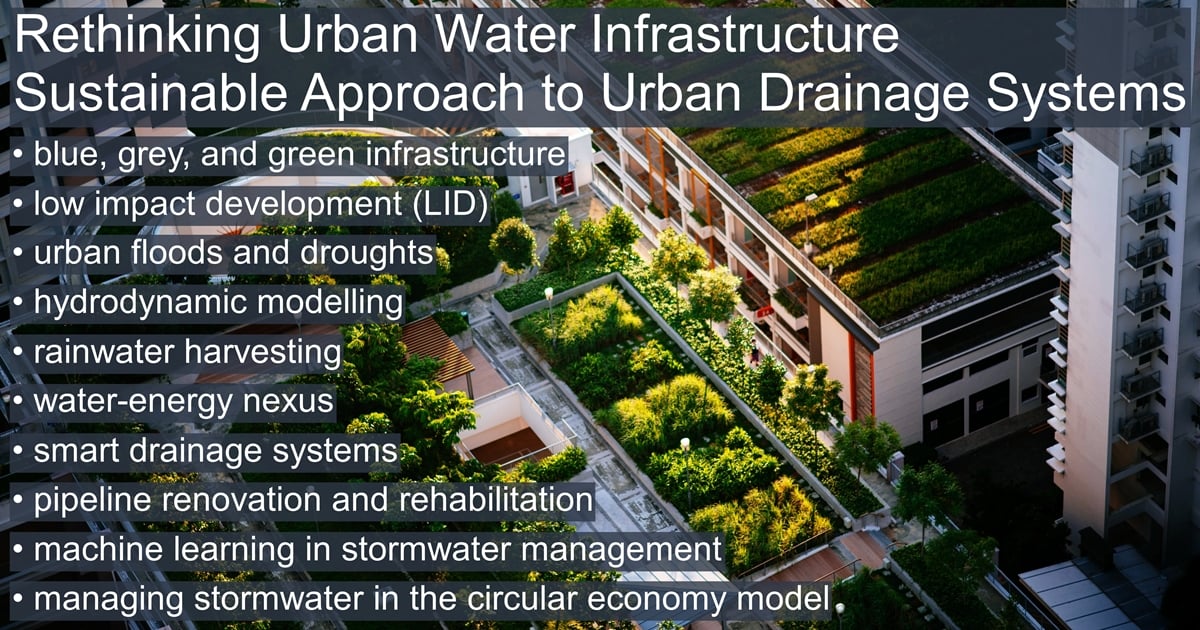Rethinking Urban Water Infrastructure – Sustainable Approach to Urban Drainage Systems
A special issue of Sustainability (ISSN 2071-1050). This special issue belongs to the section "Sustainable Urban and Rural Development".
Deadline for manuscript submissions: closed (31 August 2025) | Viewed by 5444

Special Issue Editors
Interests: sustainable water and energy management; best management practices; low impact development; hydrodynamic modeling; drainage systems; drain water heat recovery; waste heat recovery systems; sewage systems; building installations; multicriteria decision making; decision support
Special Issues, Collections and Topics in MDPI journals
Interests: direction and wave of rainfall; detention tank; stormwater management; urban environmental engineering; precipitation; rainfall; hydrodynamic modeling; SWMM; machine learning; smart drainage systems; building installations; sustainable water and energy management
Special Issues, Collections and Topics in MDPI journals
Special Issue Information
Dear Colleagues,
It is well known that urban areas are particularly sensitive to a changing climate. The increase in rainfall intensity contributes to an increase in the risk of flooding, and the increase in impervious areas hinders the natural infiltration of rainwater into the ground, intensifying the effects of droughts. Under such conditions, the interest in water management within the circular economy model is growing, and the implementation of the Sustainable Development Goals is becoming more important.
The existing literature proves that sustainable stormwater management has many advantages that can be considered on various levels, including social, economic and environmental levels. The most important advantages include flood protection, improving the condition of watercourses and the possibility of using rainwater as an alternative source of water.
To effectively manage stormwater, it is crucial to monitor and analyze meteorological and hydrological data. The use of real-time forecasting, supported by machine learning technologies, allows for faster and more accurate identification of potential flood threats. Thanks to modern technologies, such as warning systems based on advanced forecasts and smart drainage systems, decision-makers can better predict and respond to potential flood events. The implementation of these strategies can maximize the benefits of sustainable stormwater management.
Considering the impact of stormwater management on human life and health, the aim of this Special Issue is to present modern methods for stormwater management. Papers devoted to the analysis of the functioning of various types of drainage systems and facilities, technical parameters of the systems, and the use of modern methods and tools in flood risk management will be welcome.
Dr. Sabina Kordana-Obuch
Dr. Mariusz Starzec
Guest Editors
Manuscript Submission Information
Manuscripts should be submitted online at www.mdpi.com by registering and logging in to this website. Once you are registered, click here to go to the submission form. Manuscripts can be submitted until the deadline. All submissions that pass pre-check are peer-reviewed. Accepted papers will be published continuously in the journal (as soon as accepted) and will be listed together on the special issue website. Research articles, review articles as well as short communications are invited. For planned papers, a title and short abstract (about 100 words) can be sent to the Editorial Office for announcement on this website.
Submitted manuscripts should not have been published previously, nor be under consideration for publication elsewhere (except conference proceedings papers). All manuscripts are thoroughly refereed through a single-blind peer-review process. A guide for authors and other relevant information for submission of manuscripts is available on the Instructions for Authors page. Sustainability is an international peer-reviewed open access semimonthly journal published by MDPI.
Please visit the Instructions for Authors page before submitting a manuscript. The Article Processing Charge (APC) for publication in this open access journal is 2400 CHF (Swiss Francs). Submitted papers should be well formatted and use good English. Authors may use MDPI's English editing service prior to publication or during author revisions.
Keywords
- blue, grey, and green infrastructure
- hydrodynamic modeling
- urban floods and droughts
- pipeline renovation and rehabilitation
- low impact development (LID)
- rainwater harvesting
- managing stormwater in the circular economy model
- water-energy nexus
- smart drainage systems
- machine learning in stormwater management
Benefits of Publishing in a Special Issue
- Ease of navigation: Grouping papers by topic helps scholars navigate broad scope journals more efficiently.
- Greater discoverability: Special Issues support the reach and impact of scientific research. Articles in Special Issues are more discoverable and cited more frequently.
- Expansion of research network: Special Issues facilitate connections among authors, fostering scientific collaborations.
- External promotion: Articles in Special Issues are often promoted through the journal's social media, increasing their visibility.
- Reprint: MDPI Books provides the opportunity to republish successful Special Issues in book format, both online and in print.
Further information on MDPI's Special Issue policies can be found here.






